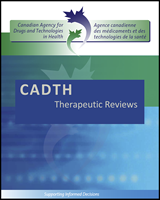Except where otherwise noted, this work is distributed under the terms of a Creative Commons Attribution-NonCommercial- NoDerivatives 4.0 International licence (CC BY-NC-ND), a copy of which is available at http://creativecommons.org/licenses/by-nc-nd/4.0/
NCBI Bookshelf. A service of the National Library of Medicine, National Institutes of Health.
Excerpt
The purpose of this report is to review the clinical effectiveness and cost of strategies to identify over-anticoagulation states and strategies to treat bleeding associated with the use of dabigatran, rivaroxaban, and apixaban, with the broader aim to help inform future listing recommendations and decisions, as well as clinical practice.
Contents
- ABBREVIATIONS LIST
- CONTEXT AND POLICY ISSUES
- RESEARCH QUESTIONS
- METHODS
- SUMMARY OF FINDINGS
- DISCUSSION
- CONCLUSIONS AND IMPLICATIONS FOR DECISION- OR POLICY-MAKING
- REFERENCES
- APPENDIX 1 SUMMARY OF NON-CLINICAL STUDIES AND CONFERENCE ABSTRACTS ON DABIGATRAN REVERSAL STRATEGIES
- APPENDIX 2 SUMMARY OF NON-CLINICAL STUDIES AND CONFERENCE ABSTRACTS ON RIVAROXABAN REVERSAL STRATEGIES
- APPENDIX 3 SUMMARY OF CONFERENCE ABSTRACT RESULTS FOR COST OF REVERSAL STRATEGY
Production of this document is made possible by financial contributions from Health Canada and the governments of Alberta, British Columbia, Manitoba, New Brunswick, Newfoundland and Labrador, Northwest Territories, Nova Scotia, Nunavut, Prince Edward Island, Saskatchewan, and Yukon.
This report is prepared by the Canadian Agency for Drugs and Technologies in Health (CADTH). It was prepared with the advice and assistance of economic and clinical experts and is a comprehensive review of the public literature available to CADTH.
The information in this report is intended to help Canadian health care decision-makers, health care professionals, health systems leaders, and policy-makers make well-informed decisions; however, the information in this report should not be used as a substitute for the application of professional judgment in any decision-making process. While CADTH has taken care in the preparation of this document to ensure that its contents are accurate, complete, and up to date as of the date of publication, CADTH does not make any guarantee to that effect. CADTH is not responsible for the quality, currency, propriety, accuracy, or reasonableness of any statements, information, or conclusions contained in the source documentation. CADTH is not responsible for any errors or omissions or injury, loss or damage arising from or relating to the use (or misuse) of any information, statements, or conclusions contained in or implied by the information in this document or in any of the source documentation.
This document and the information provided in it are prepared and intended for use in the context of the Canadian health care system. Other health care systems are different; the issues and information related to the subject matter of this document may be different in other jurisdictions and, if used outside of Canada, it is at the user’s risk. This disclaimer and any questions or matters of any nature arising from or relating to the content or use (or misuse) of this document will be governed by and interpreted in accordance with the laws of the Province of Ontario and the laws of Canada applicable therein, and all proceedings shall be subject to the exclusive jurisdiction of the courts of the Province of Ontario, Canada.
CADTH takes sole responsibility for the final form and content of this document, subject to the limitations noted above. The statements and conclusions in this document are those of CADTH and not of its advisory committees and reviewers. The statements, conclusions, and views expressed herein do not necessarily represent the views of Health Canada or any Canadian provincial or territorial government.
- New Oral Anticoagulants for the Prevention of Thromboembolic Events in Patients with Atrial Fibrillation
- New Oral Anticoagulants for the Prevention of Thromboembolic Events in Patients with Atrial Fibrillation: Recommendations
- Safety, Effectiveness, and Cost-Effectiveness of New Oral Anticoagulants Compared with Warfarin in Preventing Stroke and Other Cardiovascular Events in Patients with Atrial Fibrillation
- NLM CatalogRelated NLM Catalog Entries
- Review Bleeding with dabigatran, rivaroxaban, apixaban. No antidote, and little clinical experience.[Prescrire Int. 2013]Review Bleeding with dabigatran, rivaroxaban, apixaban. No antidote, and little clinical experience.. Prescrire Int. 2013 Jun; 22(139):155-9.
- Direct Comparison of Dabigatran, Rivaroxaban, and Apixaban for Effectiveness and Safety in Nonvalvular Atrial Fibrillation.[Chest. 2016]Direct Comparison of Dabigatran, Rivaroxaban, and Apixaban for Effectiveness and Safety in Nonvalvular Atrial Fibrillation.Noseworthy PA, Yao X, Abraham NS, Sangaralingham LR, McBane RD, Shah ND. Chest. 2016 Dec; 150(6):1302-1312. Epub 2016 Sep 28.
- Non-vitamin K antagonist oral anticoagulation agents in anticoagulant naïve atrial fibrillation patients: Danish nationwide descriptive data 2011-2013.[Europace. 2015]Non-vitamin K antagonist oral anticoagulation agents in anticoagulant naïve atrial fibrillation patients: Danish nationwide descriptive data 2011-2013.Olesen JB, Sørensen R, Hansen ML, Lamberts M, Weeke P, Mikkelsen AP, Køber L, Gislason GH, Torp-Pedersen C, Fosbøl EL. Europace. 2015 Feb; 17(2):187-93. Epub 2014 Sep 18.
- Major bleeding risk among non-valvular atrial fibrillation patients initiated on apixaban, dabigatran, rivaroxaban or warfarin: a "real-world" observational study in the United States.[Int J Clin Pract. 2016]Major bleeding risk among non-valvular atrial fibrillation patients initiated on apixaban, dabigatran, rivaroxaban or warfarin: a "real-world" observational study in the United States.Lip GY, Pan X, Kamble S, Kawabata H, Mardekian J, Masseria C, Bruno A, Phatak H. Int J Clin Pract. 2016 Sep; 70(9):752-63. Epub 2016 Aug 23.
- Review Non-vitamin K antagonist oral anticoagulants in cardiovascular disease management: evidence and unanswered questions.[J Clin Pharm Ther. 2014]Review Non-vitamin K antagonist oral anticoagulants in cardiovascular disease management: evidence and unanswered questions.Cheng JW, Barillari G. J Clin Pharm Ther. 2014 Apr; 39(2):118-35. Epub 2014 Jan 3.
- Anticoagulation Monitoring and Reversal Strategies for Dabigatran, Rivaroxaban, ...Anticoagulation Monitoring and Reversal Strategies for Dabigatran, Rivaroxaban, and Apixaban: A Review of Clinical Effectiveness
Your browsing activity is empty.
Activity recording is turned off.
See more...
